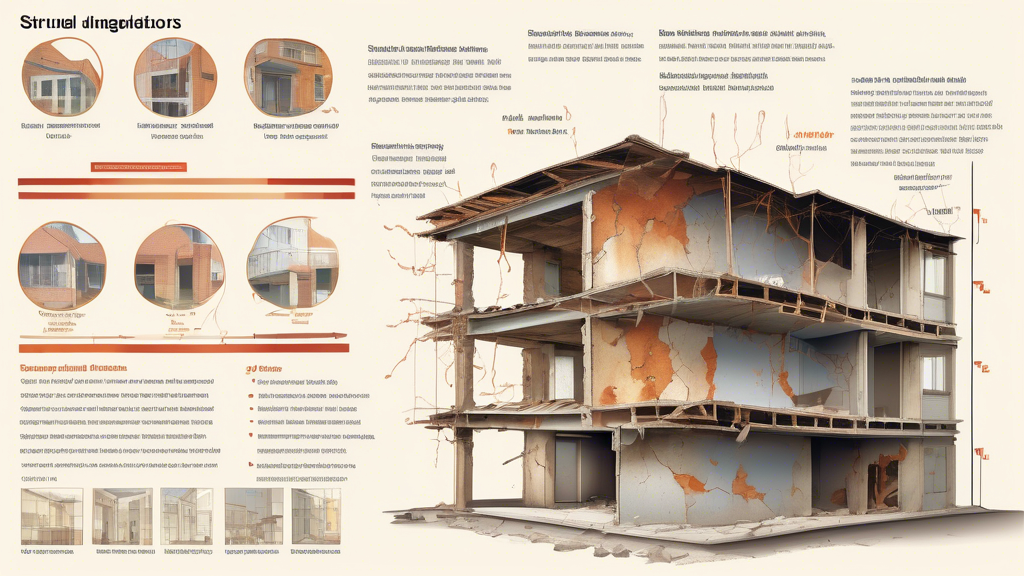

Understanding Structural Damage Indicators
Structural damage indicators are critical in assessing the integrity and safety of buildings, bridges, and other infrastructures. Identifying these indicators early can prevent catastrophic failures and significant financial losses. This article delves into the various types of structural damage indicators, their importance, and methods for monitoring them.
Types of Structural Damage Indicators
Structural damage indicators can be categorized based on the type of structure, the materials used, and the nature of the damage. Below are some of the common classifications:
1. Visual Indicators
These are the most straightforward and easily observable signs of structural damage. They include:
- Cracks: Cracks in walls, floors, or foundations can indicate settling, earth movement, or material fatigue.
- Displacement: Any noticeable shift or movement in structural components such as beams and columns.
- Corrosion: Rust or any form of material degradation seen in metal structures.
- Deformation: Warping or bending of structural elements.
2. Acoustic Emissions
Structural damage can sometimes be detected through sound waves. Acoustic emission monitoring involves capturing high-frequency sounds generated by the sudden release of energy from localized sources within the material, such as crack formation or progression.
3. Changes in Vibration Frequencies
Healthy structures have specific vibration frequencies. Changes in these frequencies can indicate damage such as cracks, loosened bolts, or other forms of degradation. Techniques like modal analysis and operational deflection shape analysis are often used to monitor these changes.
4. Load and Stress Indicators
These involve measuring stresses and loads on structural components. Strain gauges, load cells, and other sensor technologies can provide real-time data on the forces experienced by the structure, highlighting any unusual or unexpected stress patterns.
5. Environmental Indicators
The environment plays a significant role in structural integrity. Indicators like moisture levels, temperature fluctuations, and exposure to chemicals can cause or accelerate damage. Monitoring these environmental factors is essential for predictive maintenance.
Importance of Identifying Structural Damage Indicators
Identifying and addressing structural damage indicators is vital for several reasons:
1. Safety
The primary concern in any structural health monitoring is the safety of the occupants and users. Undetected damage can lead to catastrophic failures, endangering lives.
2. Cost-Effectiveness
Early detection of structural damage can save significant repair costs. Preventive measures and timely repairs are often much less expensive than addressing extensive damage after it has progressed.
3. Longevity
Regular monitoring and maintenance extend the lifespan of structures, ensuring they remain functional and safe for a longer period.
4. Legal and Regulatory Compliance
Many regions have strict building codes and standards. Regular inspection for structural damage indicators ensures compliance and avoids legal repercussions.
Methods for Monitoring Structural Damage Indicators
1. Visual Inspections
Regular inspections by trained professionals can identify visible signs of damage. Supplementing these inspections with photographic evidence and detailed records ensures changes over time can be tracked accurately.
2. Non-Destructive Testing (NDT)
Techniques such as ultrasonic testing, magnetic particle inspection, and radiographic testing help identify internal damage without harming the structure.
3. Sensor Technology
Advancements in sensor technology have made it possible to continuously monitor structural health. Sensors can now provide real-time data on stress levels, strain, and environmental conditions affecting the structure.
4. Remote Monitoring
With the integration of IoT (Internet of Things), remote monitoring systems can constantly feed data to centralized databases, allowing for real-time analysis and prompt action when necessary.
Conclusion
Structural damage indicators are essential tools in ensuring the safety, functionality, and longevity of any building or infrastructure. Through a combination of visual inspections, non-destructive testing, sensor technologies, and remote monitoring, these indicators provide valuable data that can prevent minor issues from escalating into serious problems. Regular monitoring and timely maintenance based on these indicators are crucial for sustainable infrastructure management.







